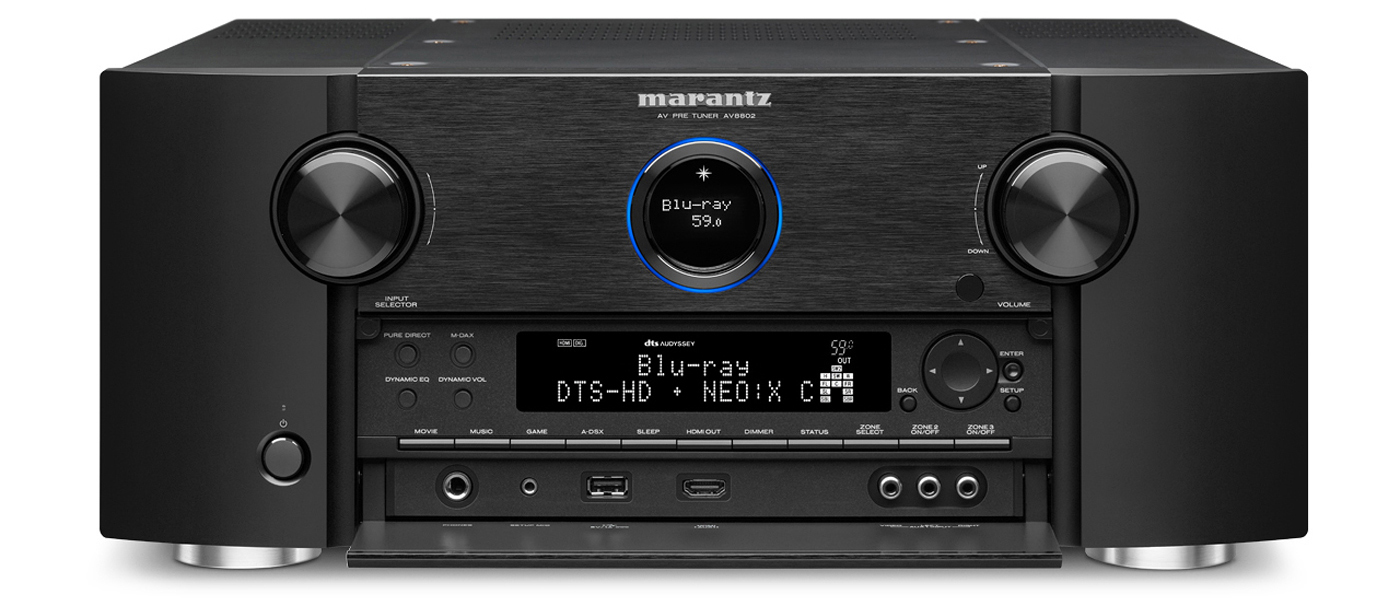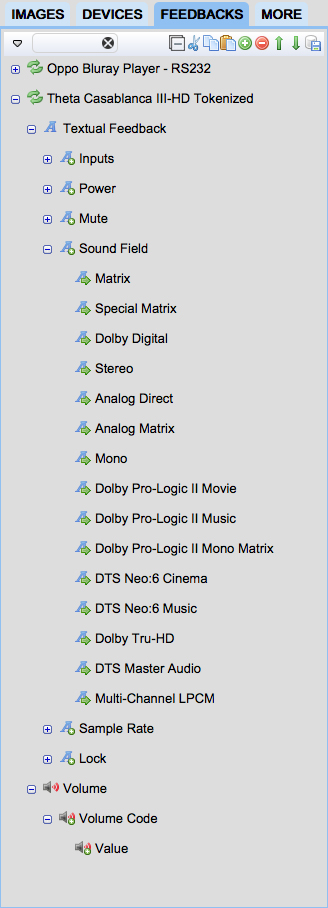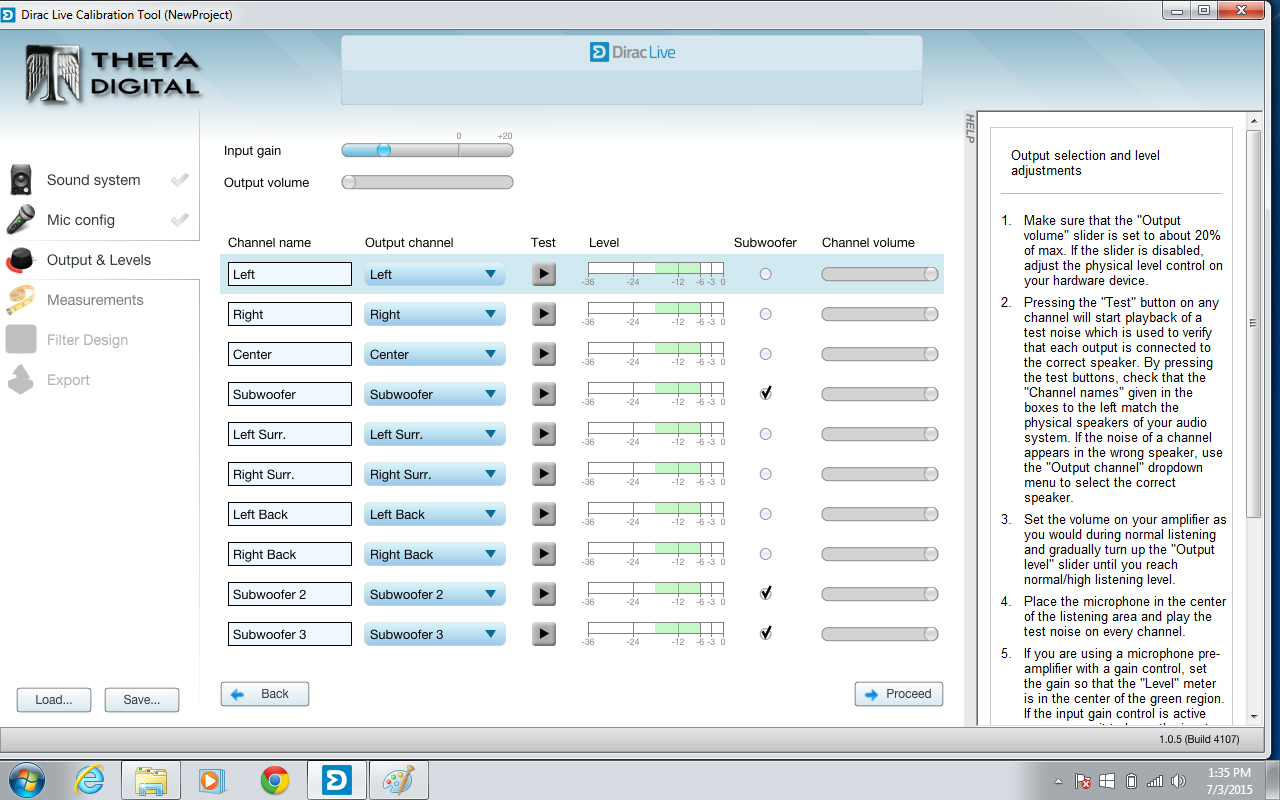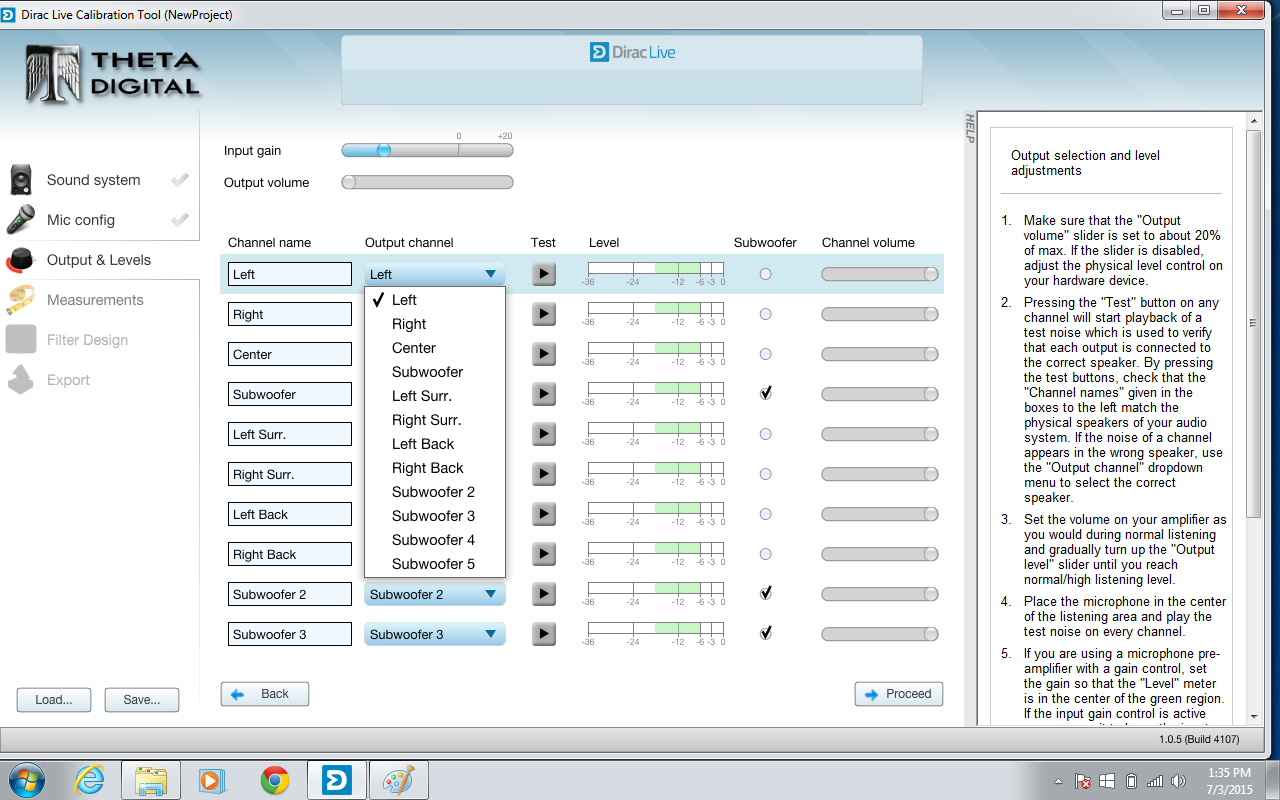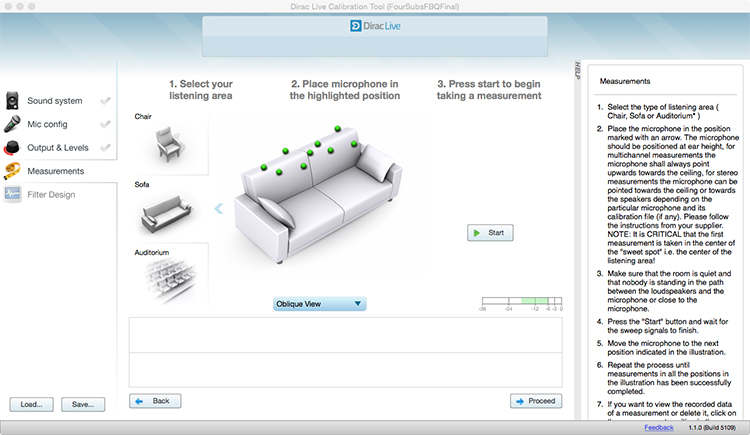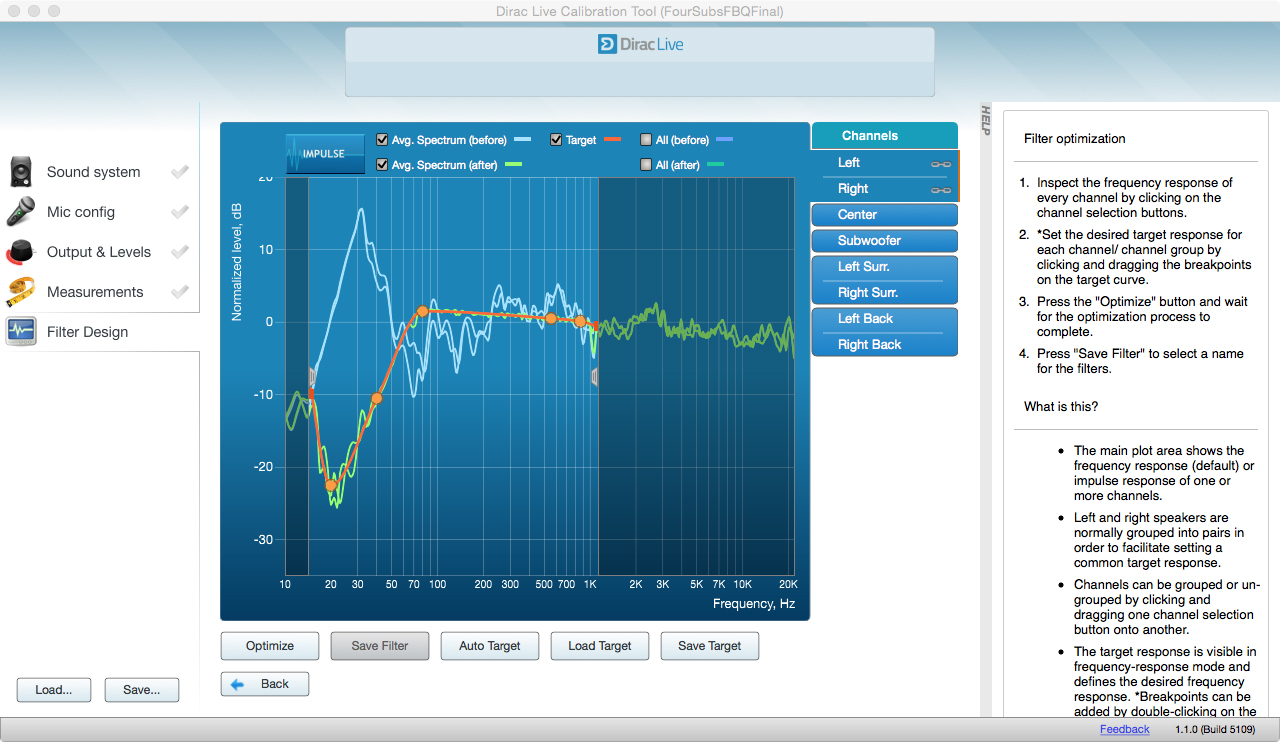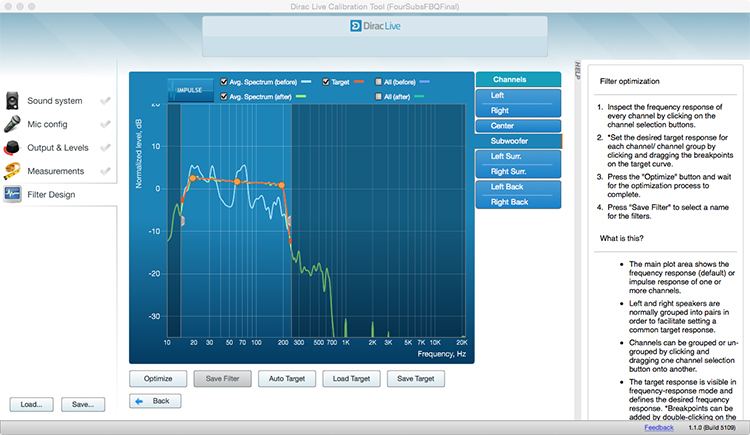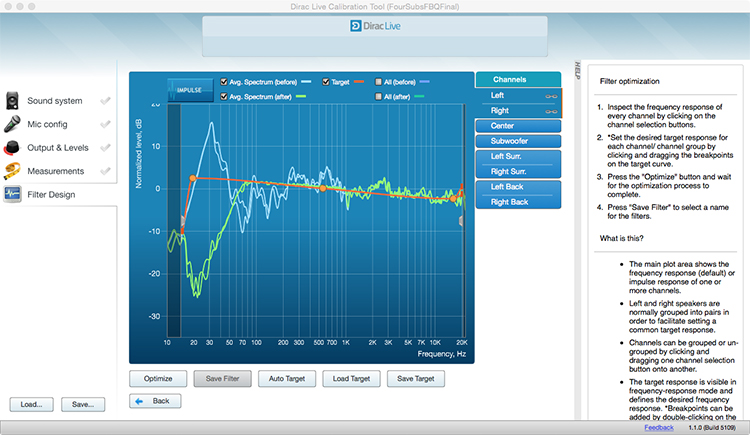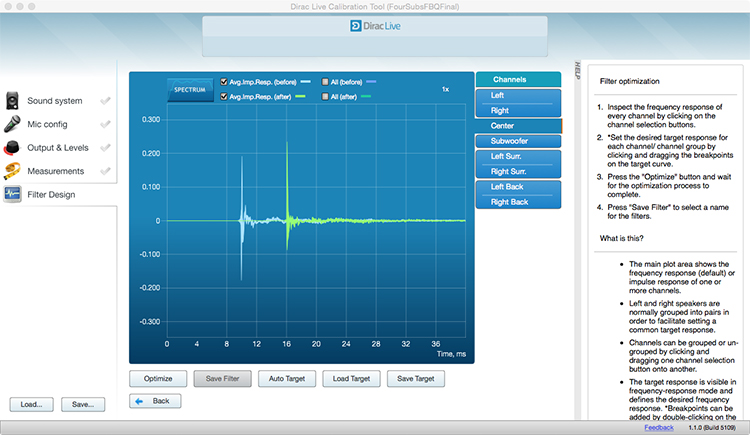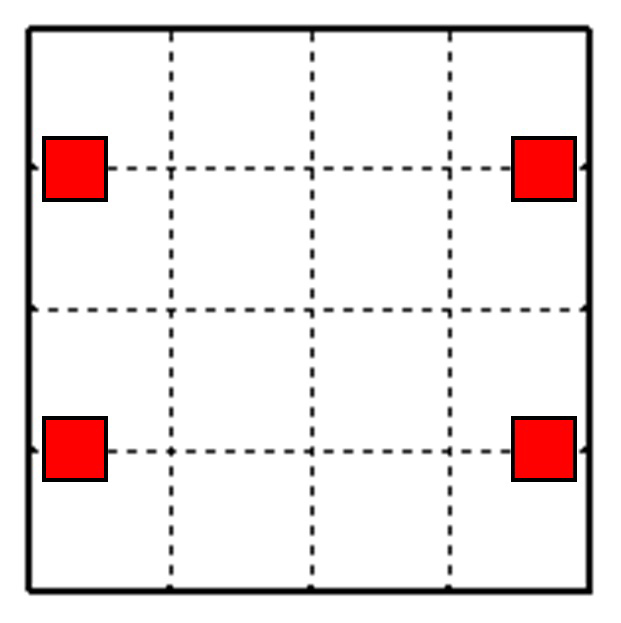Version IV brings with it an improved jitter reduction block, an updated HDMI card that allows 4k video to pass through, and a big increase in DSP horsepower, required to feed the compute hungry algorithms of Dirac Live, the RoomEQ technology Theta has adopted. Add to this Theta’s excellent build quality, and you have the makings of a reference caliber product.
I had high expectations for the sonic performance of the CB IV. How did it perform? Read on.
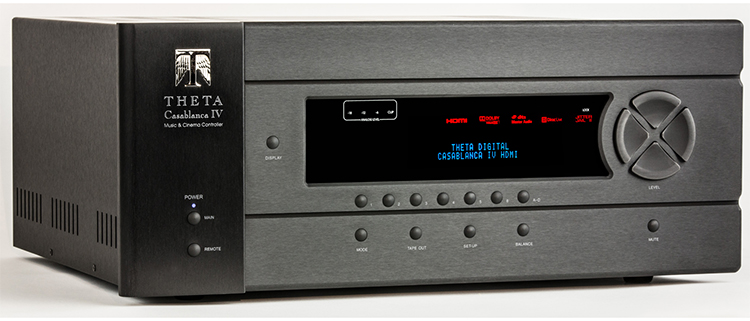
Theta continues to deliver on the promise of “no Casablanca left behind” by offering an upgrade path that goes all the way back to the first version, which was launched in 1996! This level of commitment is rare in the industry.
Version IV brings with it Dirac Live RoomEQ technology, which operates at an industry leading 96kHz. The processor requires some patience and know-how to setup. Once it’s dialed in, the sonic presentation is absolutely delightful. Highly recommended!
Theta Casablanca IV Surround Sound Processor
- Upgradeable architecture
- Continued investment in the Casablanca platform
- State of the art Dirac Live RoomEQ technology operating at an industry leading 96kHz
- Excellent build and sound quality
- Designed and built in Montebello, California
In a 2002 article in the The Audio Critic, Dr. Floyd Toole, then Vice President, Engineering for Harman Industries wrote: “The room is the final audio component. Rooms audibly modify many aspects of sound quality. Dr. Toole went on to say, “Accurate high-resolution in-room measurements along with acoustical corrections and equalization are necessary to deliver truly good sound to listener’s ears in homes and in studios.” [Theta Casablanca IV user manual]
Processing
Design:
12-Channel Preamp/Processor
DACs:
Full Balanced DACs; 4 Options
Xtreme D-3:
6-Channels, 24-bit, 192kHz, TI PCM-1792A
Xtreme D-2:
4-Channels, 24-bit, 96kHz, TI PCM-1704
Superior II:
3-Channels, 24-bit, 96kHz
Premium:
4-Channels, 24-bit, 96kHz
ADC:
20-bit, 48 kHz, Delta-Sigma
RoomEQ:
Dirac Live Operating @ 96 kHz
Dolby and DTS:
Surround Sound Processing
A/V Connections
HDMI:
4 1.4a Compatible Inputs; 1 Output
Digital Audio Inputs:
4 Coaxial (RCA), 4 Optical (Toslink), 1 AES/EBU (XLR), 1 USB for Dirac Live
Analog Audio Inputs:
6 Stereo Pairs (RCA)
Digital Outputs:
1 Coaxial (RCA); 1 Optical Toslink; Optional 12-Channel AES/EBU (XLR)
Analog Outputs:
2 Stereo Pairs (RCA); Up-to 12 Balanced Channels Based on DAC Configuration (XLR)
Control
RS-232:
1 DB9 and 1 RJ45 Connector (Rear Panel); Support for Multiple Baud Rates (4,800, 9,600, 19,200, 38,400, 57,600, 115,200)
IR receiver:
Front Panel IR Window; 3.5mm Stereo Phone Jack (Rear Panel)
Triggers:
4 12VDC Triggers (Rear Panel); 3.5mm Mono Phone Jacks
General Features
4k and 3D:
Video Pass-through
Remote:
Control
Dimensions:
7.5”H x 19”W x 16”D
Weight:
43 Pounds
MSRP:
$23,115 (8 Channel Configuration with 1 Xtreme D-2 and 1 Premium DAC Card); +$1995 for Optional 12-channel AES/EBU Digital Output Card; Individual DAC Cards: $4,995 for Xtreme D2/D3, $3,125 for Superior II, $1,875 for Premium
Company:
SECRETS Tags:
Theta, Theta Casablanca IV, Surround Sound Processors, SSP, Preamplifier
Last year during CES, I made a stop by the Theta suite to check out the Casablanca IV. A demo was on as I walked in; I sat and listened. Most tradeshow demonstrations are lackluster, in large part due to the less than ideal room conditions. This was not the case here; the bass in particular stood out. Two subwoofers, flanking the side of the listening area, were producing taut and impactful bass, and they blended seamlessly with the other loudspeakers.
A key ingredient in this mix was Dirac Live, the RoomEQ system that Theta had adopted for the Casablanca platform. I had heard of and read about Dirac Live before, but this was my first time listening to a system utilizing this technology. The processor could support up to 12 EQed channels with Dirac Live algorithms operating at an industry leading 96kHz. The next thought was obvious … get a Casablanca IV to review.
A quick glance at a CB IV might give the impression that not much has changed from the CB III HD. The exterior changes are indeed small, although they are noticeable. Adorned on the faceplate is the updated version of the Casablanca, IV in this case; accompanying this change are backlit logos of Dirac Live and Jitter Jail II on the window panel.
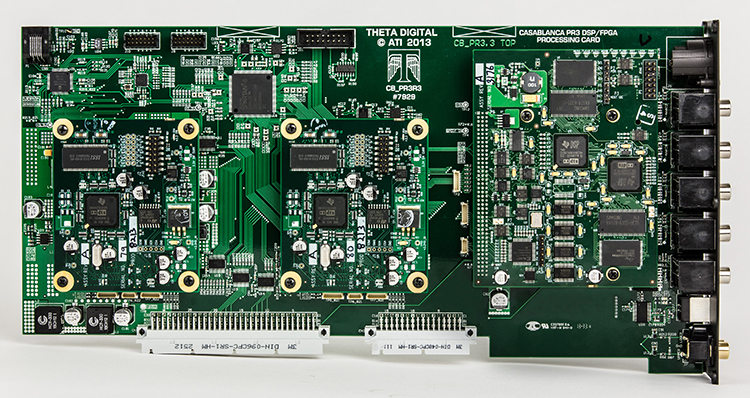
PR3 post-processing Card
The biggest changes lie inside. At the heart of the CB IV is the PR3 post-processing card. The PR3 uses a mix of DSPs and FPGAs for audio processing, and it significantly ups the compute power of the CB IV. The compute hungry algorithms of Dirac Live, operating at 96kHz, consume much of the processing power. Algorithms to decode and process a plethora of audio formats consume additional processing cycles.
A USB port is provided to interface with the Dirac Live calibration software that runs on a PC. The high communication speed supported by this interface provided for quick communication between the PC and the CB IV; RoomEQ systems that rely on RS232 communication are typically sluggish in comparison. The input stage of the PR3 also contains Theta’s Jitter Jail II circuit block; this is Theta’s updated proprietary jitter reduction mechanism.
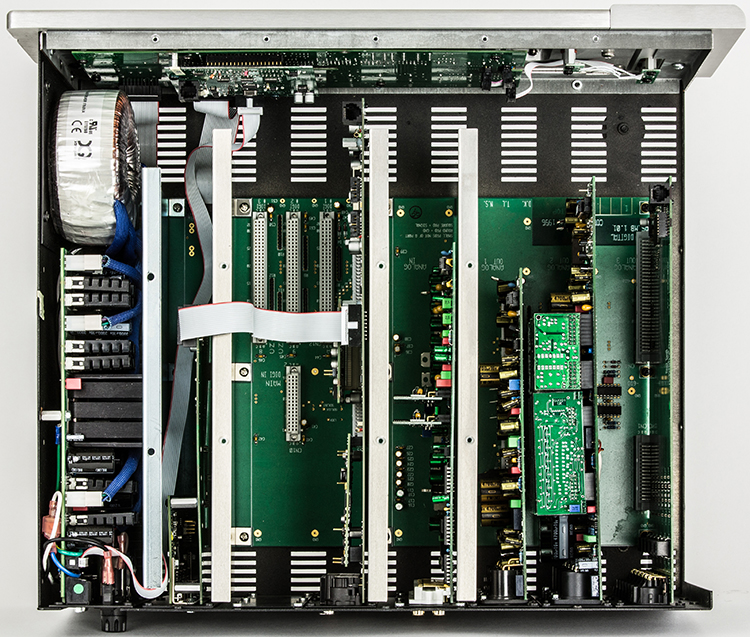
Theta has provisioned for two filter banks for Dirac Live. Presently, only one bank is active. One can assume that the second filter bank will be activated through a FW update.
The HDMI card includes four inputs that are v1.4a compliant; one HDMI output is offered. A product in this class should offer at least six inputs and two outputs. Like its predecessor, the CB III HD, the CB IV offers no video processing; the audio is stripped off from the HDMI feed and processed, and the video is passed through. 4k and 3D video formats pass through just fine.
Most of the time, I observed no handshake issues with various sources connected to the CB IV over HDMI. There were a few occasions where my projector, a JVC DLA-RS4910, locked up and required a power cycle. This projector’s HDMI receiver is somewhat temperamental, and I am inclined to fault the JVC for these lockups.

The Premium, Superior and Xtreme D-2 DAC cards remain in the mix. ATI did announce the Xtreme D-3 DAC earlier this year as future upgrade option for the CB; this card should be shipping by the time this review gets published. The Xtreme-D-3 will utilize TI’s PCM1792; this is the same part used on Theta’s standalone DAC offering, the Generation VIII Series 3.
The CB IV does not include any video processing and there is no provision for an on-screen display interface either. Setup must be done on the unit aided by the VFD. One can navigate the menu using the remote or via buttons on the front panel, which I found to be both easier and faster. Referencing the manual was a common occurrence for me during the first few weeks; thereafter, I became quite familiar with the menu structure and was able to navigate the menu system with relative ease.
Secrets Sponsor
In terms of loudspeaker configuration, the CB is unique. Each input can have an independent configuration. Additionally, Dirac Live and Jitter Jail can be enabled/disabled independently for each input. With this setup flexibility comes the potential of long setup time including many button presses. Theta has certainly given this part good thought. To ease this process, macros are offered to copy settings from one input to another set of inputs. In my case, I used the same loudspeaker configuration for all the inputs. Once I completed setting up one input, it was just a matter of copying its settings to the remaining inputs through the “copy” macro.
Theta provides a fairly comprehensive RS232 protocol for controlling the Casablanca. Baud rates up to 115,200 are supported. The current published manual is Rev 1.01, which was last updated for the CB III HD. I was told that the command set is being updated for the CB IV. There are a few commands that I would like to see get added. One request is for a command to present the source in its native format; in effect, the surround mode processing would get disabled and the same number of channels as the source signal would get output.
Another command would allow one to switch between the two Dirac Live filter banks that Theta has provisioned for; at present only one filter bank is supported, so this will hopefully come with the FW update that enables this capability. A couple of nice to have commands would allow one to toggle Dirac Live and Jitter Jail II, which will be useful for a quick A/B comparison; this can be, however, be done presently on the CB IV a couple of different ways with some effort.
iRule is the control system that I use, and I configured it to control the CB IV. The serial connection was made via the Global Cache GC-100. Designing a page with the controls I wanted to use, including some macros, did not take much time. When in use, I did run into some reliability issues; the GC-100 would occasionally freeze up, requiring a power cycle. Note that I have used the GC-100 with another processor before without any issue.
Conversations with iRule and Global Cache ensued; iRule mentioned that they had heard of similar cases with some other HW and they suggested that I insert Global Cache’s iTach IP2SL, an updated model, into the mix. I followed their suggestion and the lockups disappeared; I had reliable control of the CB IV over RS 232!
“Feedbacks” are a mechanism in iRule to read and display the value or state of a variable. The left image shows the set of variables that can be queried via iRule; once read, iRule formats the result for display in an iRule panel. With the absence of an OSD interface on the CB, “Feedbacks” provide a convenient way of monitoring the state of the CB. Through this interface, I found an anomaly with the reported sample rate; quite often, the value that iRule displayed did not match the sample rate of the incoming signal.
At first, I thought this to be an issue with iRule. I then looked at the sample rate reported on the VFD; it too was incorrect at times, and iRule and the CB did not always agree. There is no audible consequence here as the CB IV processes all signals at 96kHz; it will be nice if the correct incoming sample rate gets reported.
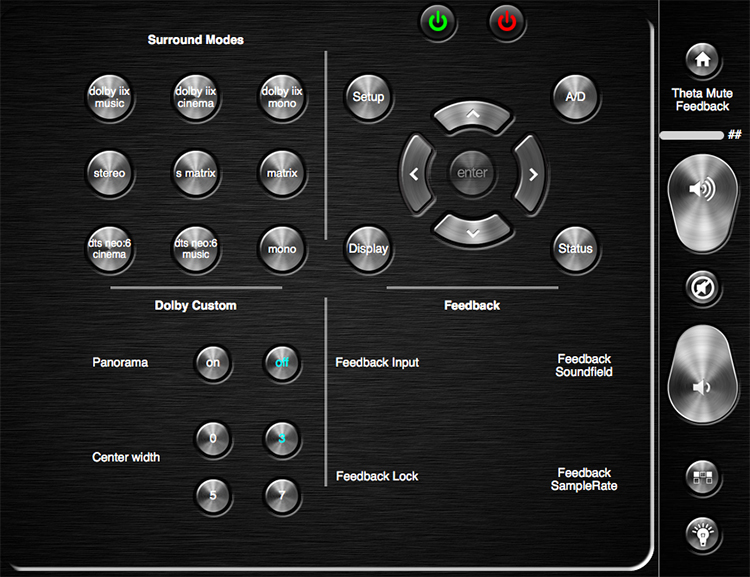
iRule panel for the CB IV
Another feedback provided via iRule is called “Sound Field”. At times, this displays the audio format of the incoming signal; at other times, it displays the processing mode being applied in the CB IV. I could not find a way to read the format of the input signal separately from the processing mode that was applied to it. It would be nice if Theta provided separate variables to decouple the audio format from the processing mode.
This feedback also alerted me to behavior of processing mode’s persistence; the CB would reset the synthesized processing mode to the default value any time it re-locked the signal. This meant that if I changed the processing mode and I skipped a track, the setting would revert to the default setting. I got used to this, however, my preference would have been for the modified setting to persist until the input was changed or the unit was power cycled.
The Dirac Live calibration process is driven via Dirac’s software that is available for download through Dirac’s website. First time users are required to go through a simple registration process. An activation key, which is included with the CB IV, is required to sign in. Once logged in, the SW, available for both Mac and PC platforms, can be downloaded and installed.
A USB microphone ships with the CB IV along with a CD containing calibration data for it. The first time the SW is launched the matching calibration data file can be loaded into the SW; subsequent sessions do not require this step unless one switches to a different microphone. The CD that I received contained several calibration data files, each named based on the serial number of the microphone; I had to match the file on the CD with the serial number on the microphone.
This was not a big deal, however, it would have been nice to only receive the file relevant for my microphone. The storage space on the CD could also be better utilized by providing the setup files to install the Dirac Live Calibration SW.
Secrets Sponsor
Accompanying the microphone is a small tripod stand. Aided by some props, mostly some boxes in my case, it can be positioned at the measurement locations. It is not very convenient though. I ended up buying a desk boom microphone stand. The arm length and height adjustability gave me enough range to position the microphone on my home theater seats.
A two-page guide describing crossover optimization through Dirac Live is included with the CB IV. This will eventually make its way into the CB IV’s manual, which is downloadable from Theta’s website. The combination of the two provides the relevant information and flow for the CB IV and Dirac Live setup/calibration.
Many folks, including myself, have a habit of ignoring manuals. In this case, I gave it a good read. I also found some additional reading material useful. MiniDSP’s user manual for their audio processors supporting Dirac Live was a good read; while there are some feature and user interface differences, the description in the setup portion is largely applicable. Robert’s review of the Emotiva XMV-1 is another recommended read. Finally, folks who are inclined to dig into the inner workings of Dirac Live can read the following 2 articles on Dirac’s website: “Dirac Live – Technical Description” and “On Room Correction and Equalization Of Sound Systems”.
The Dirac Live Calibration SW does not offer any capability to set the speaker size (crossover frequency), distance or level settings for the loudspeakers; these must be set on the CB IV. To set the levels, Theta provides the AIX Test Disc that contains the test tones. There are some test signals available on the CB; one is, however, encouraged to use the AIX disc to exercise the entire playback chain.
While I appreciate the bundling of the AIX Test Disc, I would have preferred having the capability of setting these parameters integrated with the Dirac SW. The SW already has the capability of sending a test signal to each loudspeaker, and it comes with a calibrated microphone; it’s just a matter of standardizing on an interface that allows the SW to set these parameters. Even if Dirac does not want to automate this portion, providing an interface to measure and enter the values manually would still be a welcome addition. Note that the crossover module in the CB IV gets bypassed during Dirac Live calibration.
The first step in the calibration SW involves selecting a loudspeaker configuration; 5.1, 7.1 and Custom are three options. The Custom option is to be used to create channel mappings between the Dirac SW and the CB IV. The first column shows hard-coded string names for the Dirac SW output channels. The corresponding channels that they get mapped to on the CB IV are selectable by the user.
One can play a test signal to verify that the channels are mapped correctly. The fifth column is a checkbox to specify whether the corresponding channel is a subwoofer. I am not sure why this is necessary as the string name already indicates this. The last column has a slider; this is grayed out. Presumably this option is available when one runs Dirac’s SW version on a Mac or a PC.
Note that the 5.1 and 7.1 configurations only route the bass signal to the SUB1 channel. If one has multiple subwoofers, up to 4 are supported, connected to independent DAC output channels, the custom configuration is to be used. In this case, the same bass signal gets routed to each subwoofer; each subwoofer gets its own EQ treatment. There is no option to EQ the subwoofers together.
This, I feel is an important omission, as the interaction of multiple subwoofers is what should get EQed. My setup utilizes 4 subwoofers. At first I tried to EQ them independently, and then I tried them together. The latter configuration yielded far better results; I’ll discuss this further later in the review. Dirac/Theta should consider offering this as an option while retaining independent settings for level and distance parameters.
Once the loudspeaker/subwoofer configuration is set, a level check is to be performed for each channel to ensure that the signal to noise ratio is adequate for the measurement process. This is accomplished by playing test signals through the SW, adjusting volume on the CB IV in conjunction with the input gain of the microphone, until the level indicator turns green in the SW.
The interface for this is quite intuitive, however, this is another step that I feel should get automated. Again, all the components are there for the SW to initiate a feedback loop where each channel is measured and the volume/microphone gain is adjusted to dial the levels into the desired range. In fact, this should just tie in with setting the loudspeaker levels in the first place.
Measurements at nine different locations are required. Dirac has a nice illustration of microphone positions with different viewpoints. The first measurement must be performed at the primary seating location; the remaining positions are shown as a guideline and need not be adhered to.
Dirac does recommend spreading the microphone positions even if the listener wants to optimize for the primary seat. This allows the algorithm to view how the response changes with position, which is then used to determine what is and isn’t to be corrected. The central measurement is always given the highest weight. I used the “couch” view to guide me through the measurement positions.
With the measurements done, it is time to define a target curve and optimize the filter coefficients. A default target curve is provided which covers a correction range of 15Hz-19.9kHz. The default curve does not target a flat frequency response; there is boost at the lower frequency and a gentle roll off at the high frequencies. Many psychoacoustic studies, including one done at Harman, have found a shape such as this to be preferred by listeners.
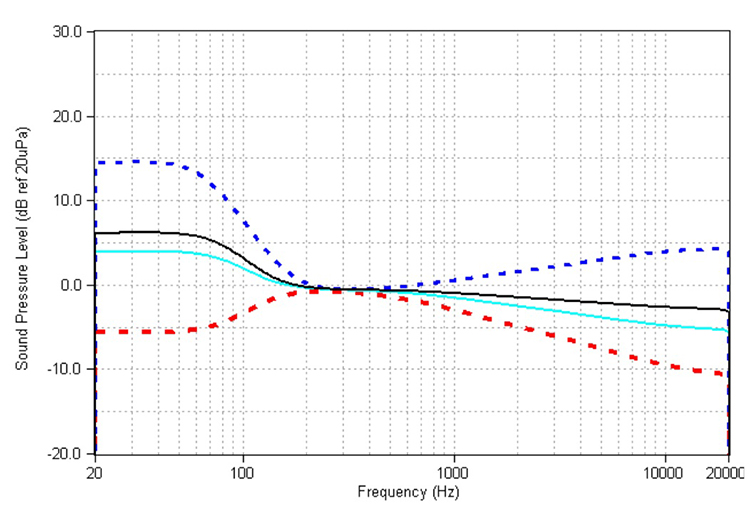
Preferred in-room loudspeaker (black) and headphone (cyan) target response curves. Dotted lines indicate the upper/lower limits of bass/treble adjustments. (Image provided by Todd Welti)
The in room response measurement for each loudspeaker can be used to determine the crossover frequency. This crossover frequency must be entered into the CB IV once the calibration process is complete. Again, it would be nice to do this through the SW!
Dirac Live does not perform any bass management. This is why the above step of entering the crossover frequency into the CB IV is required; without this, bass content in the LCR/surround loudspeakers would not get mixed in with the LFE channel … it would be lost. The CB IV supports a Linkwitz-Riley crossover with 4th order low-pass and 2nd order high-pass slopes. To make the response roll-off at 24dB per octave, adjustments must be made to the target response curve; this applies to everything but the subwoofer, which gets a 4th order roll-off through the CB IV.
Tailoring the target response is accomplished by dragging the orange dots to the desired location. Double clicking on an existing dot, deletes it; double clicking at a location where a dot does not exist, creates a new dot. The SW does some curve fitting using the dots to come up with an overall target response curve. If the space is coarsely sampled, the curve fitting may yield some undesirable inflections in some regions.
This can be remedied by inserting additional orange dots, which, if necessary, can then be dragged to the desired location. The image below shows the altered default target curve for my front left/right loudspeakers. I added two points: one at 80Hz, the crossover frequency, and the other at 40Hz, which is an octave lower, and therefore expected to be 12dB lower in level than the point at 80Hz, to get a 2nd order roll off.
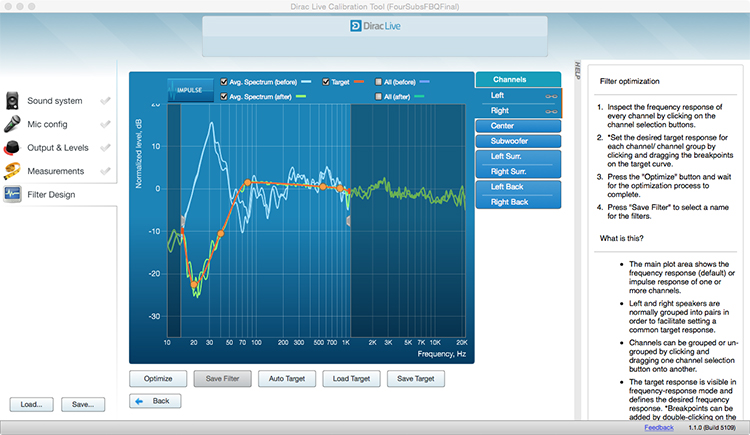
Modified target response (orange curve) for the LR channels.
Placing the dots at precise locations is a bit cumbersome. I rarely got the dot positioned at the exact location, often settling for a position that was close enough. Also, when adding a dot, it was difficult to perfectly align the mouse position with the target response curve; in such cases, the curve could shift ever so slightly. This would not have been audible, but I would have liked to be able to do this precisely through the GUI.
Also, repeating this for multiple channels added time. The SW allows for a convenient alternative; the response curve can be loaded from a text file. Even with this method, the points did not get positioned at the exact locations that I specified; they were pretty darn close though.
Once the target response curves have been set for each loudspeaker, the filter optimization can be carried out. The first time I did this, I used an old laptop and it got a really good workout … the processing took a long time to complete. As I was going to be playing around with the SW a good bit, it was time for a replacement machine, which when put into service, fared much better in this regard.
There were two issues that I ran across with the new laptop. One time the SW crashed after the measurements were made. I had not saved the measurements at this point, so I had to redo them. Another time, I suddenly started to see spurious measurements after the first location had been measured. Going back to the level check section, I saw the SW was displaying an excessive level on all loudspeakers, even though no test signal was playing. Re-seating the USB cable solved this problem. I don’t believe these issues had to do with the laptop, but it is hard to say. Both issues were observed only once.
Measured and corrected average spectrums for the center, left/right and subwoofer respectively. The big peak at about 32Hz in the left/right channel measurement corresponds to a room mode. The corrected response tracks the target response closely. Note that Dirac can apply a generous boost to the signal, which could be problematic in some systems. Dirac should consider providing a user settable boost limit in the calibration SW.
Dirac Live’s default correction covers pretty much the entire audible bandwidth. Two markers are provided to set the frequency limits. The region to the left and right of the markers is displayed in a darker color; in this range, the filters are inactive. To alter the range, one can drag the markers, or “curtains” as Dirac call them. The first time I tried to move the markers, they would not budge.
It turned out that the orange dots at the frequency extremes were preventing this; these define the frequency range over which Dirac Live operates and the “curtains” cannot be drawn inside this range. To reduce the upper limit, for example, I had to delete the rightmost orange dot. This then allowed me to draw the “curtain” in from the right; the new limit was imposed by the next in line orange dot. Another option to set the frequency limits is via the text file interface.
Default target response with a split at the upper frequency extreme for the left and right loudspeakers.
While playing with the “curtains”, I noticed something peculiar: at times the target response curve for a loudspeaker pair would split. An example of this can be seen in the figure above. I asked Dirac if this was expected behavior and they said “yes”. They explained that to prevent a discontinuity at the “curtain” limit, the optimization routine imposes a constraint requiring the target response to line up with the measured response. This was indeed the case with my measured response; hence the split.
Before/after impulse response for the center channel.
The rising response at the low-end of the frequency spectrum is attributable to the same cause. This looks worse than it is in practice, as the crossover filters in the CB IV will attenuate this region. Even so, the combined result does not yield a perfect 4th order roll-off. I tried to lower the limit, but I found the SW to be quite temperamental; either I saw little to no change or the SW crashed. I did find an option in the text file to engage an additional low-pass filter. I played with this parameter to see if I could use it to counter the rise in response; this helped, but the result was still not as smooth as I would have liked. Knowing that the crossovers in the CB IV would be active, I stayed with the default behavior in the bass region. It will be nice if Dirac is able to address this.
Once the Dirac Live calibration is complete, John recommends doing another level check and adjustment. I followed his recommendation. The loudspeaker levels typically required a minor adjustment; the subwoofer level on the other hand had to be dialed down a few notches.
My first impression of Dirac Live was mixed. The midrange showed promise; the treble was a bit polite, and the bass region, an area where I expected Dirac Live to shine, sounded a touch anemic. With multiple subwoofers at my disposal and Dirac Live’s customization options, I was optimistic that I could achieve a much better result.
I have been a fan of using multiple subwoofers for quite some time. For the last few years, I have been using four subwoofers. With previous RoomEQ systems, I had always EQed them together. Actually, EQing them separately had not been an option in those systems. This was the first time that each subwoofer got EQed individually.
During this time I was working on a Q&A with Todd Welti and Kevin Voecks from Harman; the topic, “Multiple Subwoofers: Benefits & Setup”. Todd is well known for his work on studying the benefit of multiple subwoofer configurations. In this Q&A, he describes several configurations that he found to work well in rooms.
I had been meaning to re-position my subwoofers for quite some time, and I found this a good opportunity to act on this. Using a single DAC output, I hooked the four subwoofers in a mono configuration using a combination of XLR splitters and daisy chaining. An unfortunate consequence of this was that I lost the capability to set independent delays for each subwoofer. I still had independent phase and level control, as these were available on each subwoofer.
Of the several rank ordered configurations, I decided to go with the one shown above. While this configuration did not rank the best, from a seat-to-seat variation standpoint, I picked it for two reasons: I could accommodate the subwoofers at these locations in my room; the delta between the distances to the subwoofers from the primary listening position was small. I then set the levels and played with the phase controls, which I found were best left at the default positions. For in-room measurements I used AudioTools, an iOS application that provides a fairly comprehensive set of test and measurement tools at a modest price. Next up was a Dirac Live calibration, and it was time to listen again.
What a difference! Out came an assortment of movies with deep bass: Pacific Rim, Interstellar and Need for Speed to name a few. The anemic bass I had heard before, transformed into deep and taut bass; this was by far the best bass I had heard in my room. To be sure that the improvement I was hearing did not just come from subwoofer re-positioning, I did some listening with and without Dirac Live. From listening to the system without Dirac Live engaged, I was able to hear a clear difference: the richness in the bass was simply absent without Dirac Live.
The midrange also received a noticeable uplift. This was particularly true with male vocals, where there was some added warmth. In comparison, male vocals sounded a little coarse without Dirac Live. A few high-resolution recordings that I purchased during the review were Elton John’s, “Goodbye Yellow Brick Road”, on Pure Audio Blu-Ray, Tom Petty’s 24bit/96kHz re-mastered albums, “Into the Great Wide Open” and “Full Moon Fever”, and Mark Knopfler’s “Tracker” mastered at 24bit/192kHz.
The last two artists’ recordings I purchased from HDTracks; they ended up on my Mac Mini music server. The vocal reproduction on both recordings was smooth, with just the right amount of warmth, and grain free. The same was true with movie soundtracks where dialog intelligibility improved, particularly with male voices. Every time I did a comparison with and without Dirac Live, I quickly returned to the “on” setting as I found its sound so much more inviting.
Note that there is a noticeable level difference, -8dB in my case, when Dirac Live is engaged. There is no way to adjust this amount on the CB IV; this can be adjusted on Dirac’s SW implementations. The level difference can make an A/B comparison between Dirac Live on/off difficult, as the louder sound with Dirac Live disabled might influence your judgment; though this was not the case for me. According to Dirac, this is done to provide headroom in order to avoid digital clipping. A level matched comparison can be done quite easily on the CB IV though, as level and Dirac Live settings (on/off) can be set independently for each input.
Moving on up in frequency, I found the treble to posses a relaxed quality. Over time, this polite presentation left me wanting a bit more sparkle at the top end. At first I tried boosting the treble using the acoustic controls on my front and center loudspeakers; after this I tried to boost the target response curve instead of using the loudspeakers’ acoustic control; finally I experimented with the upper correction limit in Dirac Live.
The first two changes had the expected result of boosting the treble, and this helped. What I found to work best, however, was the 3rd option. Here I played with a few cutoff options for the front loudspeakers in the 1kHz to 4kHz range. The cutoff frequency I found to work best was around 1kHz. This also lets the loudspeakers “do their thing” in the upper registers. I modified the default target response curve to be flat in the 500Hz to 1kHz range; the boost at the lower end stayed intact. When compared to the default range, this combination yielded a good overall balance while also providing a touch more air and detail with string instruments.
Jitter Jail II made a subtle, yet positive improvement in this department as well. I am curious what additional improvement the XTreme D3 DACs might bring to the table. Interestingly enough, some female vocals also benefitted. This was the case with Patricia Barber’s voice on the wonderfully recorded Café Blue album, a DSD download from Acoustic Sounds, which had more body with Dirac Live’s filters optimized for the limited range.
Two-channel music still dominates my collection and I often engage a synthesized surround sound mode. The CB IV includes the usual assortment of modes that are offered by Dolby and DTS. A few additional modes like Matrix and Special Matrix are also provided. The Matrix mode routes the sum of the left and right channels to the center channel; the surround signal is mono and it comes from the difference of the left and right channels.
Special matrix is similar to Dolby Pro Logic with more surround activity. Both modes play louder than Dolby PL IIx and adjusting the volume was necessary when comparing them. I tried these two modes on several music genres and found a few cases where Special Matrix produced a fairly enveloping soundfield that I liked with some Electronic music; in most cases, I found its over-ripe activity in the surround channels to be distracting.
Dolby PL IIx Music was the synthesized mode I gravitated towards most of the time. This mode continues to provide the best tonal and soundstage balance compared to most of the synthesized mode offerings that I have tried. Using this mode in conjunction with the “Center Width” and “Dimension” settings, I have been able to tailor the sound to my taste. The CB IV provides the “Center Width” and “Panorama” controls; both are settable via serial commands. A notable absence here is the “Dimension” control, which I like to play with; with this parameter, one can adjust for a deeper or shallower surround sound field.
When playing with the “Center Width” parameter, which I often switch between “3”, the default value, and “7”, which disengages the center channel, I found that the change did not always take effect. If I were to change the processing mode, and then switched back, the updated value from before took effect. I hope that Theta is able to resolve this bug as well as expose the “Dimension” control via a FW update.
The CB IV does accept 192kHz signals, however, when presented with a signal sampled at this frequency, Dolby/DTS processing is unavailable. I noticed this one-day while I was playing back a high-resolution recording. Switching between “Stereo” and “DP PL IIx” modes on the CB IV produced a slight audible change, though the center and surround channels were inactive.
According to John Baloff, the limitation comes from the TI chip that sits ahead of the sample rate converter. This chip prevents the signal from being down-converted to work with the Dolby/DTS processor that presumably operates at 96kHz or lower. It is not clear whether this stems from a HW limitation or whether a FW update can address this. I use Channel D’s Pure Music, running on a Mac Mini, as my audio playback engine. A sample rate ceiling can be set in Pure Music; this I set to 96kHz. Tracks sampled at a higher rate automatically got down-sampled, which made the synthesized modes available on the CB IV.
A few months into the review I observed an anomaly: loud pops coming out of one of my surround speakers. This would happen randomly and the amplifier would subsequently shut down. At first I thought that the fault lay with the amplifier; after some experimentation, I traced the problem to the DAC output of left-side surround loudspeaker. I had some unused channels on my third DAC card; with John Baloff’s help, I was able to reroute the surround signals to this DAC card … no difference.
Close to packaging and shipping the CB IV back to Theta for further inspection, I decided to re-download the Dirac filters. Viola … problem fixed! I suppose some non-volatile memory, where the Dirac filter coefficients were stored, got corrupted. This issue has not re-surfaced.
Timbre matching is another important piece of a surround sound system. The “Lichtmond 3, Days of Eternity” Blu-ray is an aural and visual delight. The 3D visuals, which make generous use of negative parallax, are extremely creative, and the accompanying 7.1 soundtrack is extremely enveloping. There is an Auro 3D track as well, which I was of course not able to try out. I have an itch to try this out on a CB IVa someday! Voices often pan around the speakers and the seamless movement breaks if one is drawn to timbre differences across different loudspeakers.
All my loudspeakers have the Revel pedigree, so they share a characteristic sound; they are not identical loudspeakers though. Even if one used identical loudspeakers, differences in room placement alone would affect the sound. With Dirac Live in the mix though, the voice pans were extremely good. If I paid close attention, I could still hear slight differences as the voices moved from one loudspeaker to the next, however, there was marked improvement with Dirac Live.
By John Johnson
All distortion measurements were made within an 80 kHz bandwidth. Coax cables were used for the analog measurements, and an AES/EBU (XLR) cable was used for the digital measurements.
First, let’s go over the analog tests for a baseline to compare with digital processing.
At 1 kHz, distortion was a very reasonable 0.008%, at 2 volts output.
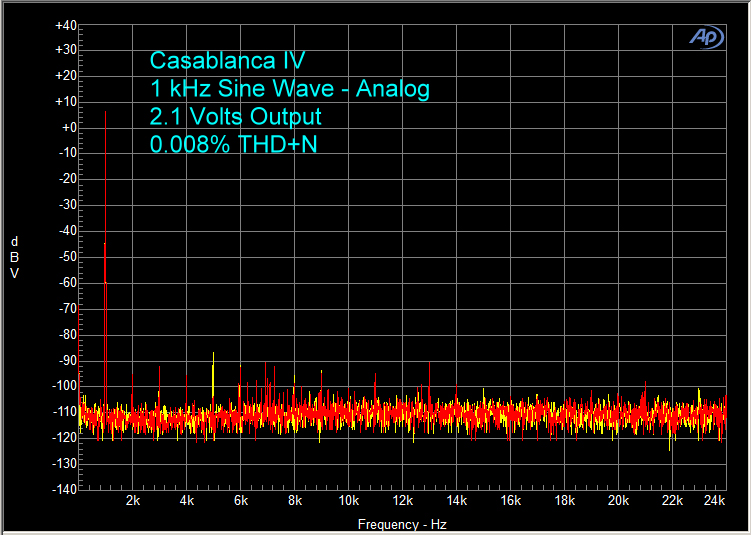
Using 19 kHz and 20 kHz, there was a -97 dB 1 kHz B-A peak, which is inaudible. All other distortion peaks were below -90 dB. At this level, the peaks would be just barely audible if the volume is loud.
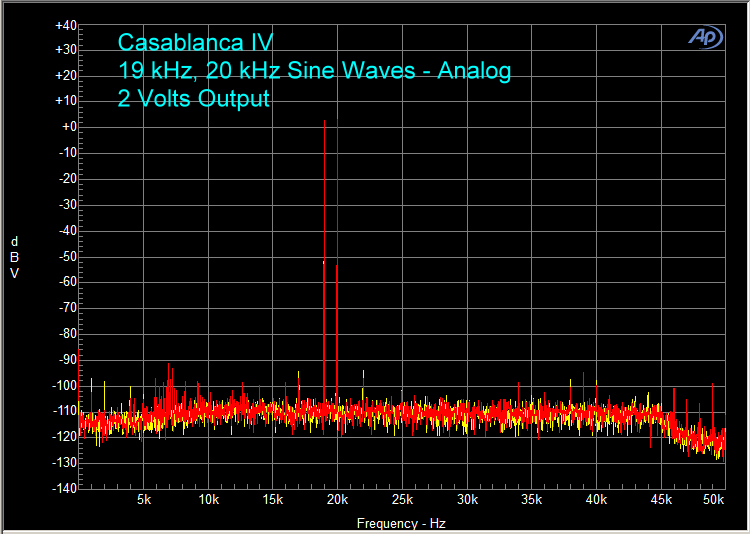
IMD was a very low 0.001%, an excellent result. This is arguably the most important test. High IM results in loss of detail and midrange congestion.
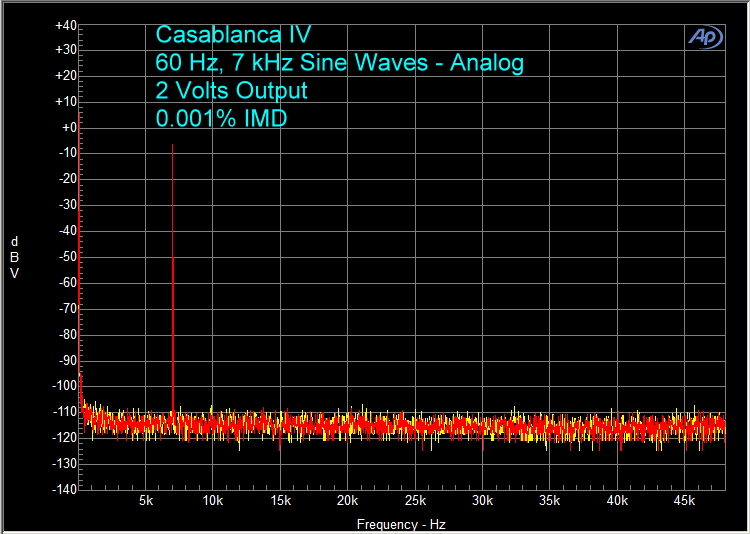
In the Distortion vs. Frequency Response, the audible band stayed within 0.001% and 0.005%.
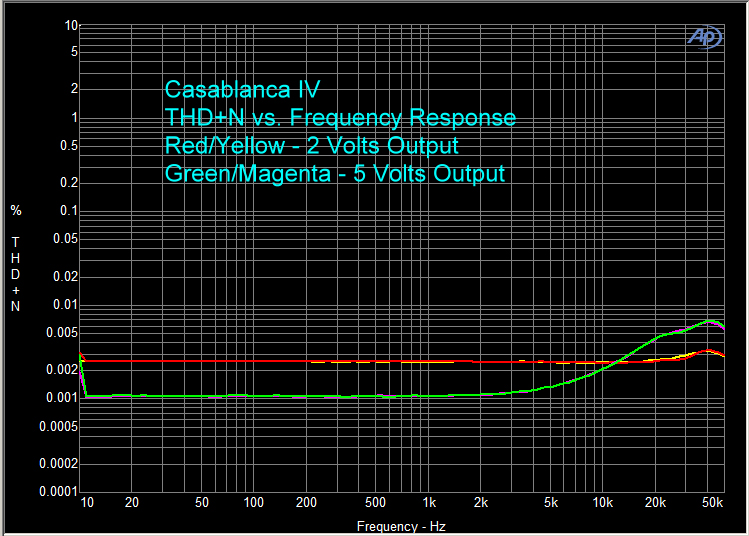
Distortion vs. Output Voltage showed a sharp knee at 7 volts, and the second knee at 24 volts. This was into 100 kOhms. The sharp knee represents the end of the portion of the useful output. After that, distortion rises very quickly. Clipping occurred at 26 volts.
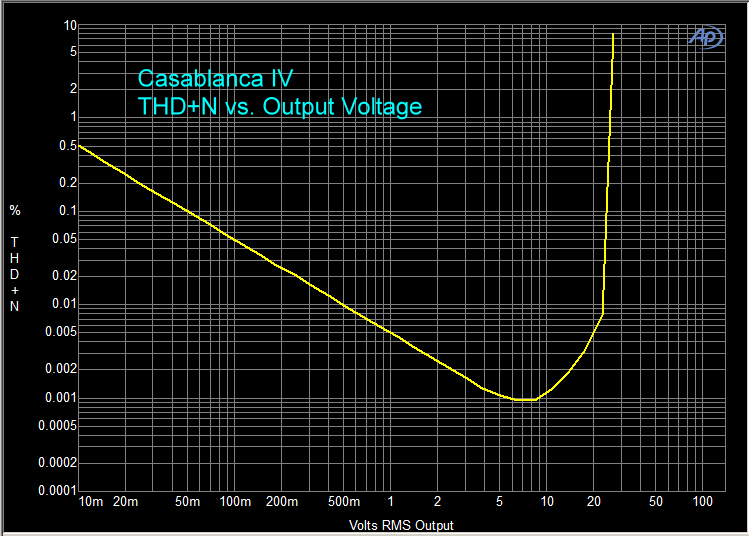
The analog frequency response was flat out to 10 kHz, where it began to rise, with the maximum at 65 kHz, before dropping precipitously.
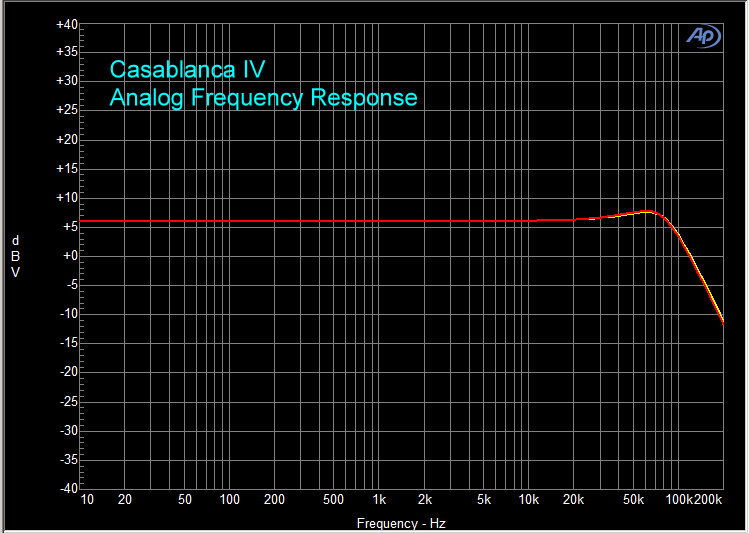
Now for the digital tests. Using 16/44.1 sampling, distortion was 0.005%, which was a bit higher than the analog test. There were 21 harmonic peaks, but they were all lower than -90 dB.
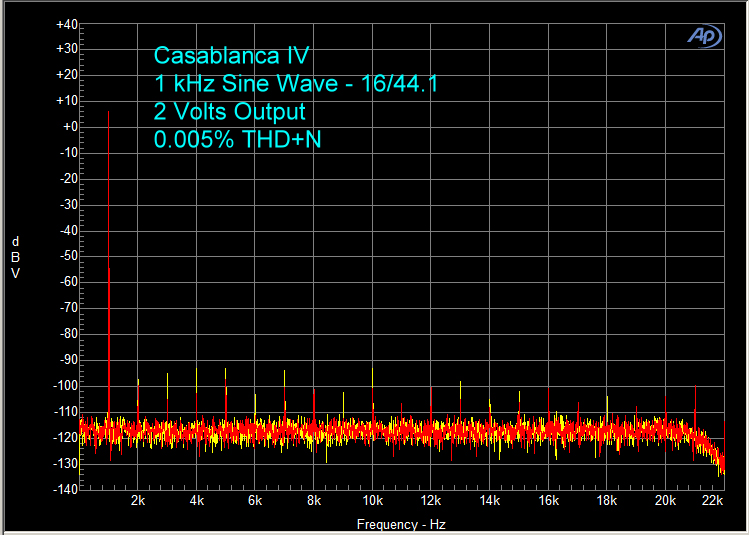
Using 24/96 sampling, distortion declined marginally.
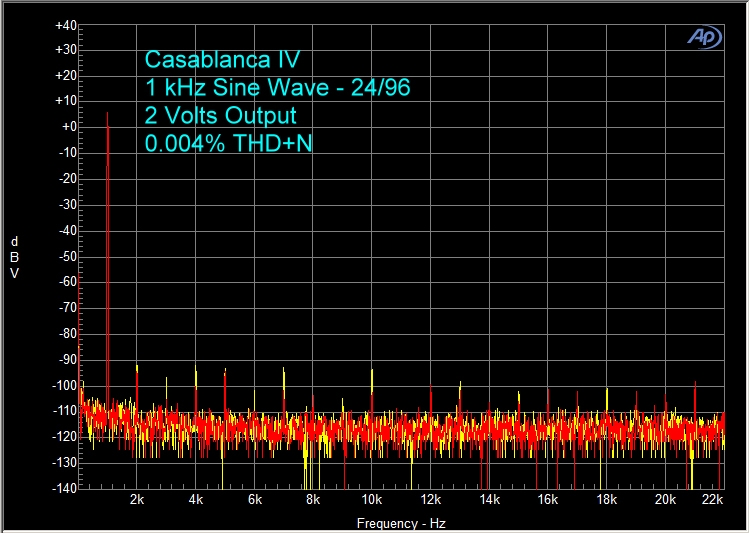
With 19 kHz and 20 kHz sine waves, the B-A peak at 1 kHz was buried in the noise floor, and in general, there were less distortion peaks than at 16/44.1.
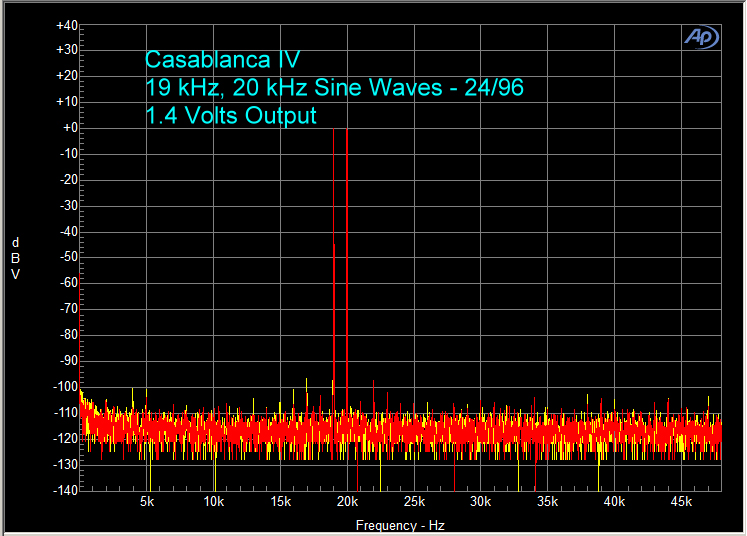
IMD at 24/96 sampling was 0.012% and 2 volts output.
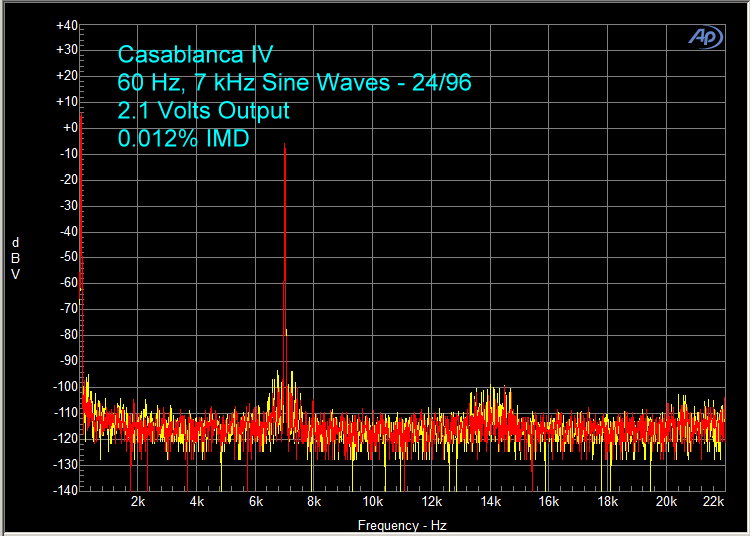
The frequency response at 24/96 was flat to 20 kHz and down 0.5 dB at 48 kHz.
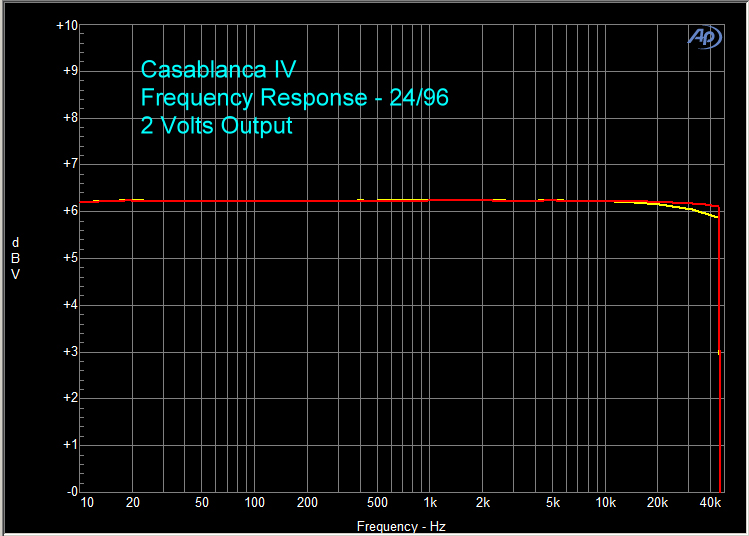
At 24/192 sampling, response was similar to 24/96 sampling. This is because the Casablanca uses 24/96 sampling for all digital signals, including Dirac room correction.
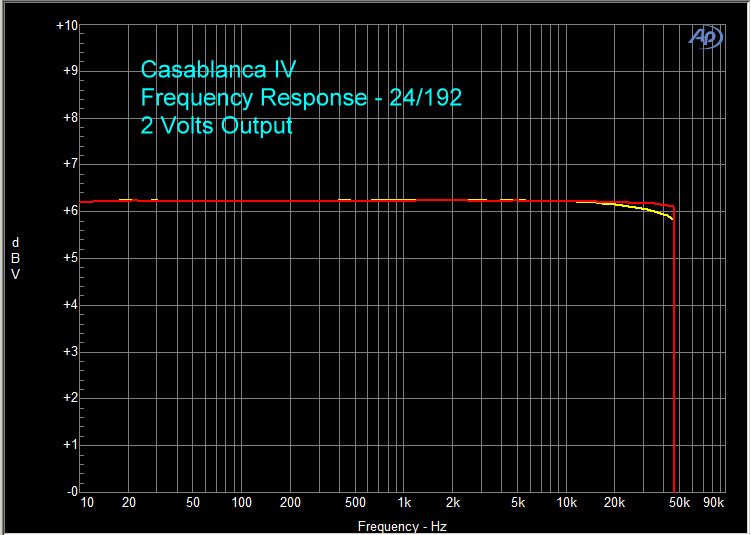
The bench tests were very good, and the Casablanca IV would be a wise investment because it is built to be upgradeable by switching out cards in its slots. So, the processor could add all the new codecs as they are developed. It is also extremely flexible, allowing outputs to be assignable to such things as five discrete subwoofers.
THE CASABLANCA platform continues to lead the premium surround sound processor market by offering both hardware and firmware upgrades.
- Upgradeable hardware
- Dirac Live RoomEQ operating at 96kHz
- New Xtreme D3 DAC card (not reviewed) offers more channels and improved performance at the same price as the Xtreme D2 DAC card
- Excellent build and sound quality
- Excellent technical support
- Tighter integration between the Dirac Live SW and the CB IV
- Ability to EQ multiple subwoofers together with independent distance/level control
- Support for multiple Dirac Live filter banks
- Desktop configuration tool
- Synthesized surround modes with 192kHz signals
I thoroughly enjoyed my time with the CB IV. The improvements brought about by Dirac Live were impressive: bass reproduction elevated to a level I had never heard before in my room; dialog intelligibility improved, as did the consistency of timbre across my loudspeaker array. I never felt the urge to disengage Dirac Live. RoomEQ systems are not always met with warm embrace. If you are in this camp, I highly recommend auditioning a CB IV at a dealer, and I hope that your opinion on deploying this technology in your system will change.
In as much as I loved what Dirac Live did to the sound of my system, it fell short in one area: ease of use. I would like to see better synergy between Dirac and Theta. A number of steps could stand automation and a number of parameters could be set via Dirac’s SW, obviating the need to set some parameters on the processor and some through the calibration SW. Some aspects of the user interface in the calibration SW could also be refined.
I would also welcome a desktop configuration utility from Theta to setup the inputs and modes on the Casablanca. A product at this price point will likely get setup by a dealer, so most customers are unlikely to experience the setup process; still, dealers, and folks like myself, would appreciate steps from both companies that would make this process easier.
When questions arose, I always found an adept hand at both Theta and Dirac. At Theta, I interfaced with John Baloff and Sanjay Durani; together they form one of the best technical support teams in the industry. I exchanged several emails with these gentlemen and even talked to Sanjay on the phone a few times. These folks know their stuff, and they take great pride in the work they do. I certainly appreciate their help. At Dirac, I exchanged several emails with Flavio Fellah who answered several technical questions related to the SW and Dirac’s algorithms. The responses were prompt, and I did not get the feeling that I was receiving special attention.
The price of entry into this platform is high. I would love to see ATI bring a 96kHz implementation of Dirac Live to a lower cost offering; perhaps the resurrection of the Casanova platform or integration into a top of the line B&K processor, another brand that ATI owns. A processor with a price point closer to Anthem’s D2V 3D, which is an excellent value, would certainly appeal to a broader market segment.
For anyone who is able to afford this price point, the CB IV should be at the top of the audition list. This is an excellent sounding processor with a bright future. Theta is now shipping the updated DAC cards. The CB IVa upgrade, announced earlier this year, should be available next year; this upgrade will add support for the new 3D audio formats.
Theta also announced the CB E, which will support more than 12 channels, although there will be a new chassis for this model. Anyone invested in this platform or looking to invest in this platform should find comfort with these announcements; ATI, the brand owner, is showing strong commitment to keeping this platform at the forefront of the premium processor market. Highly recommended!
With the Theta CB IV SSP and Dirac Live, bass reproduction elevated to a level I had not experienced in my home theater!
Associated Equipment
Speakers: Revel Ultima Studio2/Voice2, Revel Performa M105 (surround channels)
Subwoofers: Revel B15a (pair), Paradigm Studio Sub 12 (pair)
Amplifier: Classe CA-M300/CA-2300, Proceed AMP5
Optical Media Playback: OPPO BDP-105D
Music Server: Apple Mac Mini; connected to SSP via Bryston BUC-1 USB converter
Projector: JVC RS4910
Screen: Steward StudioTek 130 G3
Cables: AntiCables, Pangea, Blue Jeans, Monoprice
System Control: iRule
Power: PS Audio Power Plant Premier and P10
Acoustic Treatment: ASC SoundPlanks/Iso-Wall/Soffit/TubeTraps, Vicoustic Multifuser DC2


